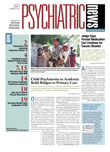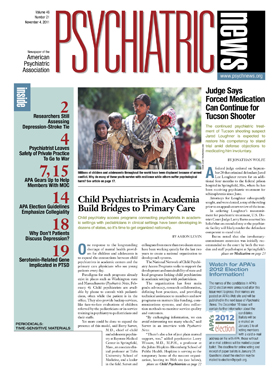Sleep Disorders Prevalent With Mental Illness
Researchers at Johns Hopkins Bloomberg School of Public Health recently examined the prevalence of sleep problems and their association with the use of inpatient and emergency department services by Medicaid recipients with serious mental illness. Their sample consisted of 1,560 psychiatric patients with Medicaid coverage who were identified in a 10-state random survey of psychiatrists. Sleep problems were assessed by clinicians' clinical judgment, rated on a scale as none, mild, moderate, or severe. The researchers hypothesized that patients with sleep problems would be more likely to have psychiatric hospitalizations and psychiatric emergency department visits than those without sleep problems and that use of these services would be more prevalent among patients with more severe sleep problems.
They found that about 80 percent of patients in the sample had some sleep problems, according to ratings by their psychiatrists. Approximately half of patients were described as having either moderate or severe problems, suggesting that sleep problems were highly prevalent in this population.
"More careful monitoring and management of sleep problems in this patient population could address a common clinical need and might help to reduce costly service use," said the researchers. They called for the use of standardized measures in routine practice settings, such as the Pittsburgh Sleep Quality Index and the Insomnia Severity Index, to improve clinicians' ability to screen for and diagnose sleep disturbances and monitor treatment responses.
PTSD Responds to CBT Plus Paroxetine
The combination of prolonged exposure, a cognitive-behavioral therapy (CBT), and paroxetine was more effective in the treatment of posttraumatic stress disorder (PTSD) related to the World Trade Center attack than prolonged exposure plus placebo.
Researchers at Columbia University Medical Center studied adults who were referred by clinicians, responded to advertisements, or responded to direct mail to individuals who had either sought help from the Mental Health Association of New York City for difficulties related to the World Trade Center attacks or who participated in the World Trade Center Health Registry and screened positive for PTSD (score of 50 or more on the PTSD Checklist).
Thirty-seven survivors of the WTC attacks with PTSD were randomly assigned to 10 weeks of treatment with prolonged exposure (10 sessions) plus paroxetine (n=19) or prolonged exposure plus placebo (n=18). PTSD severity was assessed using the Clinician-Administered PTSD Scale and the 7-point Clinical Global Impressions of Change scale.
Patients treated with prolonged exposure plus paroxetine showed significantly greater improvement in PTSD symptoms and remission status. Response rate and quality of life were also significantly more improved with combined treatment.
"Combined treatment medication and prolonged exposure therapy deserves further study in larger samples with diverse forms of PTSD and over longer follow-up periods," concluded the researchers.
The study was supported by a National Institute of Mental Health grant to coauthors Randall Marshall, M.D., and Franklin Schneier, M.D. Schneir has received research funding from Forest Laboratories, and Marshall is currently employed by SunovionPharmaceuticals. Glaxo-SmithKline provide the paroxetine and matching placebo tabled used in this study.
Children With Certain Migraines Have More Prevalent Patent Foramen Ovale
Researchers at the University of Utah have concluded that children with migraine with aura have a significantly higher prevalence of patent foramen ovale (PFO) compared with those without aura or with the general population. They studied 109 children and adolescents aged 6 to 18 who were diagnosed with migraine headache (38 with aura and 71 without) by pediatric neurologists from February 2008 to September 2009. The children were evaluated for PFO and right-to-left shunting with color-flow Doppler scanning, saline solution contrast transthoracic echocardiography, and contrast transcranial Doppler scanning
The overall PFO prevalence in the study cohort was 35 percent; in the general population it is 25 percent. PFO prevalence in subjects with aura was significantly greater (50 percent), but similar to the general population in those children without aura.Atrial shunt size was not associated with the presence or absence of aura.
The researchers believe their data suggest that PFO may contribute to the pathogenesis of migraine with aura in children and may have implications for clinical decision making.
McCandless R, Arrington C, Nielsen D, et al. Patent Foramen Ovale in Children With Migraine Headaches. J Pediatr. 2011. 159(2):243-247. An abstract is posted at <www.ncbi.nlm.nih.gov/pubmed/21450305>
The High Cost of Insomnia
Adverse effects on work performance are consistently ranked among the most prominent components of the societal burden of insomnia. Estimates of annual insomnia-related workplace costs due to excess sickness absence, reduced work productivity, and workplace accidents and injuries in the U.S. civilian workforce range between $15 billion and $92 billion.
With the America Insomnia Survey, researchers sought to estimate the prevalence and associations of broadly defined insomnia (without comorbid conditions) with work performance. A national sample of 7,428 employed health-plan subscribers over age 18 responded to a telephone survey. Broadly defined insomnia was assessed with the Brief Insomnia Questionnaire. Work absenteeism and presenteeism (low on-the-job work performance defined in the metric of lost workday equivalents) were assessed with the WHO Health and Work Performance Questionnaire.
The estimated prevalence of insomnia was 23.2 percent. Insomnia was significantly associated with lost work performance due to presenteeism but not absenteeism, with an annualized individual-level association of insomnia with presenteeism equivalent to 11.3 days of lost work performance. The authors called for effectiveness trials to obtain precise estimates of return-on-investment of programs that help employees manage insomnia.
Kessler R, Berglund P, Coulouvrat C et al. Insomnia and the Performance of U.S. Workers: Results From the America Insomnia Survey Sleep. 2011. 34(9):1161-1171. An abstract is posted at <www.ncbi.nlm.nih.gov/pubmed/21886353>.
Depressed Females Show Molecular Evidence of Brain Changes
Women are twice as likely as men to develop major depressive disorder (MDD) and are more prone to recurring episodes. Researchers at the University of Pittsburgh School of Medicine tested the hypothesis that the illness may associate with robust molecular changes in women and investigated large-scale gene expression in the postmortem brains of 21 women with MDD and 21 similar women without a history of depression.
Their search focused on the lateral/basolateralbasomediancomplex of the amygdala as a neural hub of mood regulation affected in MDD.
Among the most robust findings were downregulated transcripts for genes coding for γ-aminobutyric acid (GABA) interneuron-related peptides, including somatostatin, tachykinin, neuropeptide Y, and cortistatin, in a pattern reminiscent of that previously reported in mice with low brain-derived neurotrophic factor (BDNF).
BDNF itself was significantly downregulated at the RNA and protein levels in subjects with MDD. Investigating putative mechanisms, the researchers showed that this core MDD-related gene profile is repeated by complementary patterns in mice with constitutive or activity-dependent decreases in BDNF function. They concluded that these findings provide both direct and indirect evidence for reduced BDNF function in the amygdala of femalesubjects with MDD.
"Our findings give us a better understanding of the biology of this common and often debilitating psychiatric illness," said senior author Etienne Sibille, Ph.D., an associate professor of psychiatry at the University of Pittsburgh School of Medicine.
Guilloux JP, Douillard-Guilloux G, Kota R, et al. Molecular Evidence for BDNF- and GABA-Related Dysfunctions in the Amygdala of Female Subjects With Major Depression. Mol Psychiatry. 2011 Sep 13 [Epub ahead of print]. An abstract is posted at <www.ncbi.nlm.nih.gov/pubmed/21912391>.
Intensive Control of Diabetes Doesn't Improve Cognition
People with type 2 diabetes are at risk of cognitive impairment and brain atrophy. Researchers at the National Institute on Aging compared the effects on cognitive function and brain volume of glycemic control. Their findings did not support the use of intensive therapy to reduce the adverse effects of diabetes on the brain.
The Memory in Diabetes (MIND) study was conducted at 52 clinical sites in North America as part of Action to Control Cardiovascular Risk in Diabetes (ACCORD), a clinical trial supported by the National Institutes of Health that evaluated the effects of intensively targeting blood sugar control among adults with established diabetes, high blood sugar levels, and pre-existing heart disease or at least two cardiovascular disease risk factors in addition to diabetes. In the MIND study, hemoglobin A1C levels, a standard measure of average blood sugar levels over the preceding two to three months, were used to monitor participants' blood sugar. A total of 2,977 participants aged 55 to 80 with type 2 diabetes, high A1C levels, and a high risk of cardiovascular events were randomly assigned to receive either intensive glycemic control or standard glycemic control. The intensive strategy group targeted an A1C blood sugar level of less than 6.0 percent, similar to that found in adults without diabetes. The standard strategy group aimed to lower blood sugar levels to an A1C of 7.0 to 7.9 percent, similar to what is achieved, on average, by individuals treated for type 2 diabetes in the United States.
Cognitive primary outcome was assessed at baseline and at 20 and 40 months using the Digit Symbol Substitution Test (DSST) score. Total brain volume, the primary brain structure outcome, was assessed with MRI at baseline and 40 months in a subset of participants.
In February 2008, raised mortality risk (19 percent excess mortality at five years) led to the end of the intensive treatment and transition of those participants to standard treatment. There was no significant treatment difference in mean 40-month DSST score. The intensive-treatment group had a greater mean total brain volume than the standard-treatment group.
Although significant differences in total brain volume favored the intensive treatment, cognitive outcomes were not different. "Combined with the nonsignifican effects on other ACCORD outcomes, and increased mortality in participants in the intensive treatment group, our findings do not support the use of intensive therapy to reduce the adverse effects of diabetes on the brain in patients with similar characteristics to those of our participants," concluded the researchers.
Launer L, Miller M, Williamson J, et al. Effects of Intensive Glucose Lowering on Brain Structure and Function in People With Type 2 Diabetes (ACCORD MIND): A Randomised Open-Label Substudy. Lancet Neurol. 2011. Sep 27. [Epub ahead of print]. An abstract is posted at <http://ajp.psychiatryonline.org/Article.aspx?ArticleID=179993>. 
